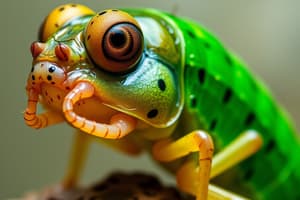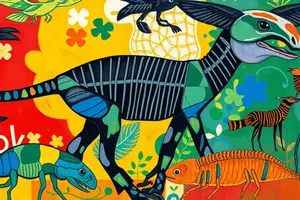Podcast
Questions and Answers
What are the two phyla in the Animal Kingdom?
What are the two phyla in the Animal Kingdom?
Vertebrates and Invertebrates
How many classes of vertebrates are there?
How many classes of vertebrates are there?
- 6
- 4
- 3
- 5 (correct)
What class of vertebrates has gills and fins?
What class of vertebrates has gills and fins?
Fish
Which class of vertebrates lives in water as young and on land as adults?
Which class of vertebrates lives in water as young and on land as adults?
Which class of vertebrates is covered with scales and breathes with lungs?
Which class of vertebrates is covered with scales and breathes with lungs?
Which class of vertebrates has feathers?
Which class of vertebrates has feathers?
What do mammals produce for their young?
What do mammals produce for their young?
What type of animals are heterotrophs?
What type of animals are heterotrophs?
What protects the internal organs of vertebrates?
What protects the internal organs of vertebrates?
What are the cold-blooded animals?
What are the cold-blooded animals?
What are the three body parts of insects?
What are the three body parts of insects?
What are structures that help take in oxygen from water called?
What are structures that help take in oxygen from water called?
Animals are called ___ because they cannot make their own food.
Animals are called ___ because they cannot make their own food.
How many legs do insects typically have?
How many legs do insects typically have?
How many legs do spiders have?
How many legs do spiders have?
What is the process of shedding an exoskeleton called?
What is the process of shedding an exoskeleton called?
What are the marine animals with a hard external shell called?
What are the marine animals with a hard external shell called?
What type of tissue helps birds maintain body temperature?
What type of tissue helps birds maintain body temperature?
What is the largest kingdom with over 1 million known species?
What is the largest kingdom with over 1 million known species?
Flashcards are hidden until you start studying
Study Notes
Animal Kingdom Classification
- Divided into two main phyla: Vertebrates (with backbone) and Invertebrates (without backbone).
- Vertebrates consist of five classes, which include fish, amphibians, reptiles, birds, and mammals.
Invertebrates
- Includes various animals, which are classified based on structures like exoskeletons or body parts.
Vertebrate Classes
- Fish: Breathe through gills and have scales and fins.
- Amphibians: Live in water as juveniles and on land as adults; lack scales but may have fins.
- Reptiles: Land animals covered in scales; breathe using lungs.
- Birds: Noted for feathers; most can fly.
- Mammals: Covered in hair, maintain a constant body temperature, and produce milk for their young.
Characteristics of Animals
- Complex cells make up all animals.
- Heterotrophs: Animals cannot produce their own food and rely on consuming plants and other animals.
- Endoskeleton in vertebrates provides organ protection and body support.
- Warm-blooded vertebrates maintain a constant body temperature, including mammals and birds.
- Cold-blooded vertebrates' body temperature varies with the environment, including fish, amphibians, and reptiles.
Reproductive Characteristics
- Mammals typically gestate their young inside the mother's body; some may develop in pouches or hatch from eggs.
Additional Animal Classes
- Insects: Possess an exoskeleton, segmented bodies with three parts: head, thorax, and abdomen.
- Arachnids: Have a hard exoskeleton and jointed appendages; typically have eight legs.
- Crustaceans: Live in aquatic environments, usually having a hard outer shell.
- Mollusks: Generally soft-bodied with some covered by a hard outer shell.
- Echinoderms: Marine animals known for having arms or spines radiating from a central body.
Sensory and Physical Features
- Antennae serve as sense organs on the heads of arthropods.
- Molting is the process of shedding an exoskeleton in arthropods.
Body Structures
- Coelom: A fluid-filled body cavity containing internal organs.
- Insects have six legs, spiders have eight, and crabs typically have ten legs.
Fossil Record
- Fossils provide evidence of historical fauna, leaving prints or marks as remnants of their existence.
Studying That Suits You
Use AI to generate personalized quizzes and flashcards to suit your learning preferences.




